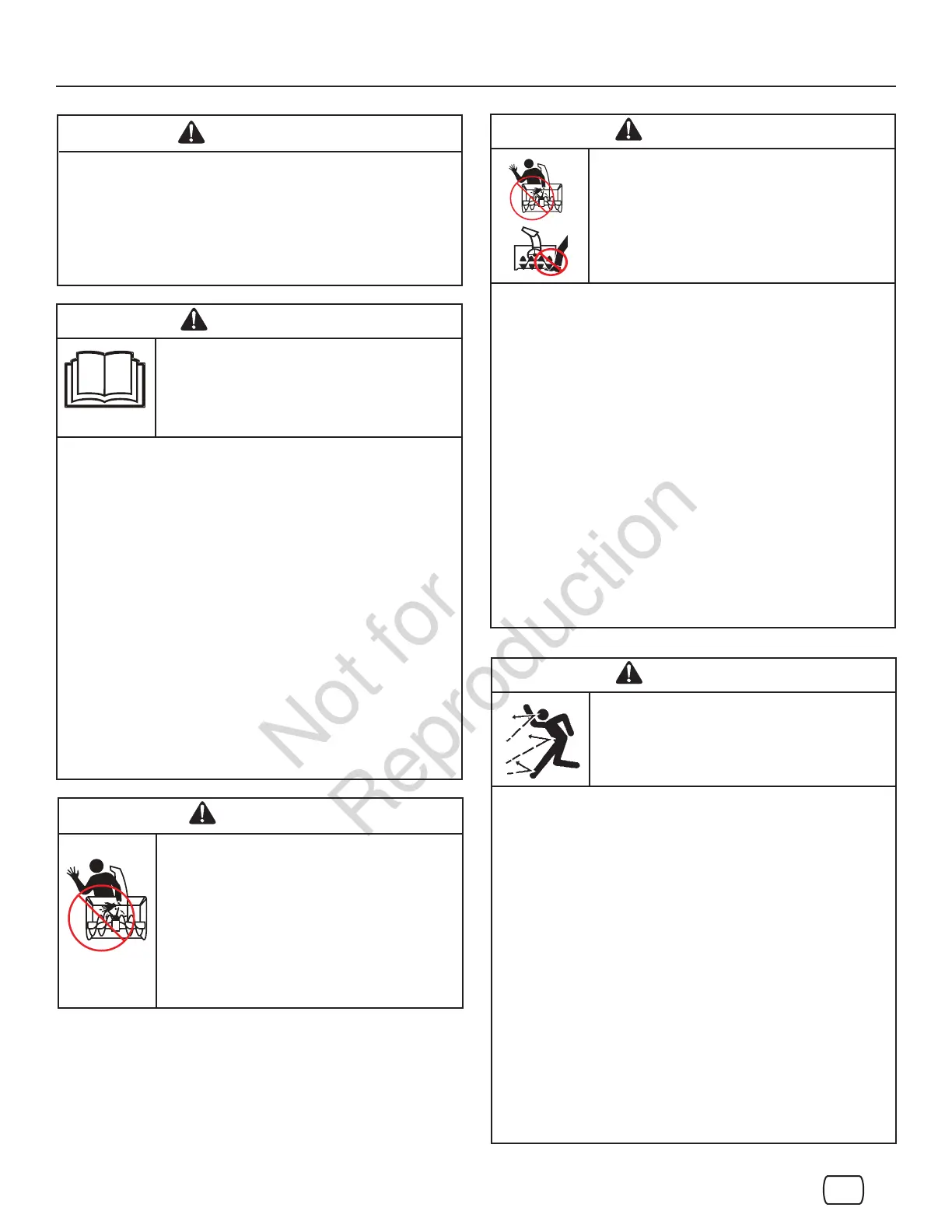3
en
Operator Safety
DANGER
• Whenever cleaning, repairing, or inspecting the
snowthrower, make sure the engine is OFF, spark plug wire
is disconnected, and all moving parts have stopped.
• Do not put hands or feet near or under rotating parts. Keep
clear of the discharge opening at all times.
• Never operate the snowthrower without proper guards, and
other safety devices in place and working.
• Never leave the snowthrower unattended while engine is
running. Always disengage the auger and traction controls,
stop engine, and remove keys.
• Keep all loose clothing away from the front of the
snowthrower and auger. Scarves, mittens, dangling
drawstrings, loose clothes, and pants can quickly become
caught in the rotating device and amputation will occur. Tie
up long hair and remove jewelry.
• Run the machine a few minutes after discharging snow to
prevent freeze-up of the collector/impeller.
• Disengage power to the collector/impeller when
snowthrower is transported or not in use.
Keep hands, feet, and clothing away from
rotating parts. Rotating parts can contact
or entangle hands, feet, hair, clothing, or
accessories.
Failure to observe these safety instructions
will result in traumatic amputation or severe
laceration.
WARNING
• Always wear safety glasses or eye shields during
operation, and while performing an adjustment or repair.
• Always be aware of the direction the snow is being
thrown. Nearby pedestrians, pets, or property may be
harmed by objects being thrown.
• Be aware of your environment while operating the
snowthrower. Don’t run over items such as gravel,
doormats, newspapers, toys, and rocks hidden under
snow, as they can all be thrown from the chute or jam in
the auger.
• Use extreme caution when operating on or crossing
gravel drives, walks, or roads.
• Adjust the collector housing height to clear gravel or
crushed rock surface.
• Never operate the snowthrower near glass enclosures,
automobiles, window wells, drop-offs, and the like without
proper adjustment of the discharge chute angle.
• Familiarize yourself with the area in which you plan to
operate the snowthrower. Mark off boundaries of walkways
and driveways.
Objects can be picked up by auger and thrown
from chute. Never discharge snow toward
bystanders or allow anyone in front of the
snowthrower. Failure to observe these safety
instructions will result in death or serious injury.
WARNING
• Hand contact with the rotating impeller inside the discharge
chute is the most common cause of injury associated with
snowthrowers.
• This snowthrower is capable of amputating hands and feet,
and throwing objects. Read and observe all the safety
instructions in this manual. Failure to do so could result in
death or serious injury.
WARNING
• Save these original instructions for future reference.
• Be thoroughly familiar with the controls and the proper use
of the snowthrower.
• Make sure you are properly trained before operating the
snowthrower.
• Know how to stop the unit and disengage the controls
quickly.
• Never allow anyone to operate the snowthrower without
proper instruction.
• Always follow the instructions in the operator’s manual, if
the snowthrower will be stored for an extende d period.
• Maintain or replace safety and instruction labels as
necessary.
• Never attempt to make major repairs on the snowthrower
unless you have been properly trained. Improper servicing
of the snowthrower can result in hazardous operation,
equipment damage, and voiding of the product warranty.
Read, understand, and follow all the
instructions on the snowthrower and in the
operator’s manual before operating this unit.
Failure to observe the safet y instructions in this
manual could result in death or serious injury.
Discharge chute contains rotating impeller
to throw snow. Never clear or unclog the
discharge chute with your hands. Fingers can
quickly become caught in the impeller. Always
use a clean-out tool.
Failure to observe these safety instructions
will result in traumatic amputation or severe
laceration.
DANGER
